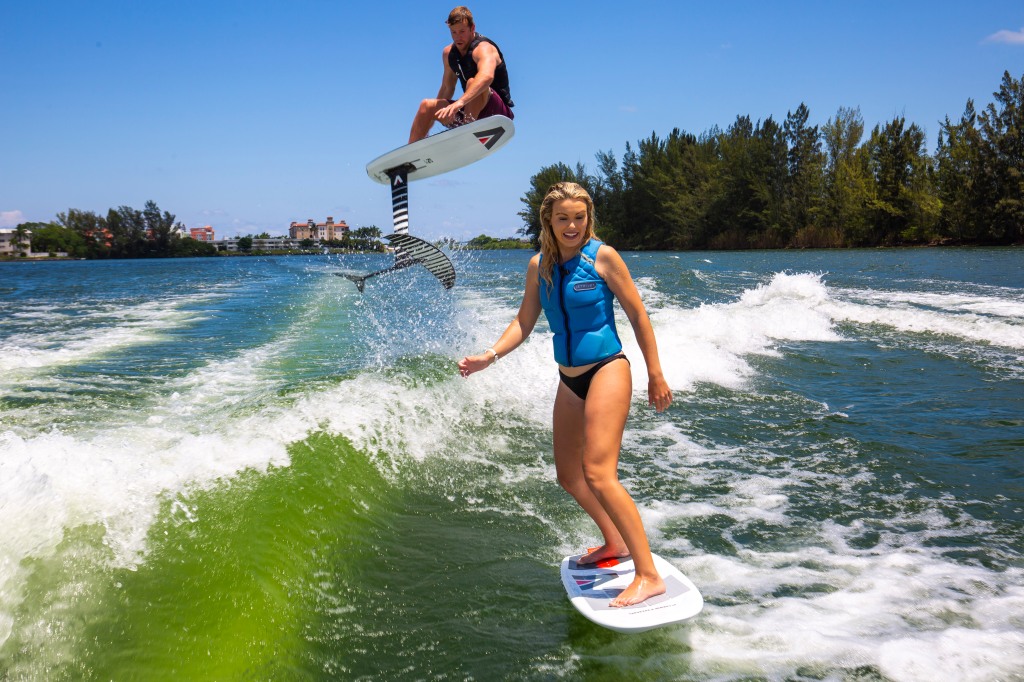As a water sports enthusiast, you’ll have access to all the fun under the sun. This means boards, and gear beyond your wildest dreams. Gear that even starts thinking about flying. Not the regular getting-on-a-plane type of flying but one involving water. Foiling might give thrill seekers the exciting flight experience they’re looking for.
Foiling is a relatively new addition to the world of watersports that’s already taking the sport by storm. Besides redefining the way we ride, and what we consider a rideable wave; the foil makes the rider feel like they’re flying. Foiling has a lot more to offer. Unfortunately, it comes with a steep learning curve and not-so-standard surfing equipment.
At Miami Nautique, we’re committed to helping water sports enthusiasts get their foil on. Here’re a few tips on getting into the activity and other relevant information to help foil surfers know their foil and ride like a pro.
How to Foil Like a Pro
Most water sports enthusiasts have probably seen a video of pros catching waves and pumping away on their foil. Fortunately, everyone has the chance to do that, but first, they need to know the basics.

Look for the Right Balance
Poor balancing is the biggest mistake beginners make when trying to foil. Foiling requires more accurate feet and body positioning than wakesurfing, waterboarding, or windsurfing. When starting, try keeping the body weight balanced on the front foot. As you shift your weight more toward the back of the foil you’ll rise up out of the water. Find the balance between too heavy on the front foot and too much weight back, causing the foil to soar out of the water.
Keep the board’s nose down until the board becomes properly balanced, and ride at a slow, stable speed. Once stable and in motion, shift the body weight to the other foot and start pumping. In addition, heavier riders can balance better on larger boards. With more experience, the foil rider can shift to a smaller foil with improved maneuverability.
Safety First
Who would have thought a helmet could come in handy in a watersport? Well, when foiling, safety has to come first. When foil riders fall off, the board sometimes stays on the foil and continues moving. Also, the new board could spin around and hurt the rider if they are not careful.
Know the Foiling Equipment
The foil comprises several crucial parts, including the mast, top plate, fuselage, front wing, and back wing. Everything from the fin’s length, profile, stiffness, and shape directly impacts the foil’s functionality.

The Mast and Top Plate
The mast and top plate typically connect the board and other parts of the foil. They vary in length, with shorter masts being an excellent option for beginners as they are closer to the water’s surface. A shorter mast also enables the foil to handle small waves in shallow water. Once riders get comfortable on the shorter mast, they can improve their skill on longer ones.
Fuselage
The fuselage connects the wing foil to the board. Generally, the longer the fuselage, the more stable the foil. A longer fuselage also makes it easier to pump movements with feet and improves dynamism.
The Wings
Each wind foil has two wings positioned in a similar manner to that of an aircraft. There is a larger front wing and a smaller back wing. Both wings have a bulbous side and a flat side. The front wing’s bulge is at the top, while the back wing’s bulge is at the bottom. This design pulls the rear down, allowing for an easier takeoff.


Choose the Right Foil
Like with surfboards, foils and boards come in various types and materials. Most foils get made from aluminum or carbon. Carbon foils are typically lighter and stiffer than aluminum foils. But they’re also more expensive than aluminum foils. On the other hand, carbon foils give a smoother feeling when foiling and are slightly safer than their aluminum counterparts.
Foil riders also have to pick between hard or inflatable boards. Inflatable boards are light, easy to carry, and safer than hard boards. On the downside, they have limited stability and responsiveness. Hard boards, on the other hand, offer more stability and responsiveness. They’re, however, more costly than inflatable boards.
Forget the Knowledge Learnt in Surfing
Besides the similar-looking board and a few activities like paddling and catching waves, foiling is an entirely different sport from surfing. Even the paddling aspect isn’t quite the same since a rider has to deal with a weird pendulum motion when foiling. Therefore, when foil surfers embark on the journey to mastering foiling, they treat the sport as something they’ve never done before and learn as they continue.
Ready to Try Out Foiling?
Despite the apparent difficulty in foiling, a foil surfer can master the sport through practice and determination. Water sports enthusiasts ready to try this incredible sport can check out our online store or visit us in Florida for all foiling equipment. Foil riders can also sign up for our newsletter and receive special deals on Liquid Force foils .









